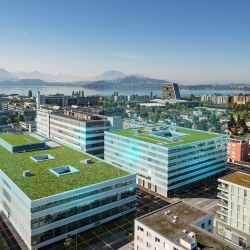April 1, 2021
‘Healthy buildings’ enjoy a surge in demand worldwide
 A new survey of many of the world’s leading real estate investors finds that 92 percent of respondents expect demand for healthy buildings to grow in the next three years. The report claims that this is a compelling signal of the direction the real estate sector is heading. This finding, among others, is captured in a report titled A New Investor Consensus: The Rising Demand for Healthy Buildings (registration) which claims to be a comprehensive health and wellness study of global real estate investment managers and stakeholders representing aggregate AUM of $5.75 trillion and portfolio investments in real estate totalling approximately US$1.03 trillion.
A new survey of many of the world’s leading real estate investors finds that 92 percent of respondents expect demand for healthy buildings to grow in the next three years. The report claims that this is a compelling signal of the direction the real estate sector is heading. This finding, among others, is captured in a report titled A New Investor Consensus: The Rising Demand for Healthy Buildings (registration) which claims to be a comprehensive health and wellness study of global real estate investment managers and stakeholders representing aggregate AUM of $5.75 trillion and portfolio investments in real estate totalling approximately US$1.03 trillion.
Coordinated by the United Nations Environment Programme Finance Initiative (UNEP FI), the Center for Active Design (CfAD), and BentallGreenOak (BGO), the study defines healthy buildings as those optimised for occupant health and safety through a mix of siting, design and operational strategies that measurably improve physical, social and mental health indicators.
The report suggests that COVID-19 has elevated the importance of health in investment decision-making, with 89.5 percent of respondents signalling their intent to enhance their wellbeing-related asset management strategies in the coming year. The need for healthy buildings has been steadily rising over the last decade, with nearly 70 percent of respondents indicating that they were seeing increased demand prior to the pandemic.
The report claims to highlight an increasing investor awareness of the importance of health and wellbeing to their environmental, social and governance (ESG) strategies and the link between building design and function, and personal and societal health and wellness. This has given rise to a more concerted focus on the “S,” or social component of ESG, which has traditionally lagged behind the more well-defined environmental and governance pillars. Currently, only 53 percent of respondents report that they incorporate health and wellness into their ESG strategies to a great extent and 42 percent note that they have begun to do so, leaving significant room for growth.
A new focus
Joanna Frank, president and CEO of CfAD and its Fitwel certification system, added, “This study quantifies for the first time the extent to which the industry is focusing on health and wellness in ESG investment strategies. We expected the findings to demonstrate strong demand for healthy buildings, especially given the pandemic, but it also points out the lack of consistency around measuring and reporting the impacts of these initiatives. There’s a clear case for standardizing benchmarks to track performance. Certifications like Fitwel can provide a framework, but we need to keep pushing for broad adoption so that we can track the measurable impacts.”
Eric Usher, Head of UNEP FI, stated, “We know from our members that there is broad consensus for finance actors to think holistically about the impacts they are creating through their capital allocation decisions, and that attention to societal goods is part of the value creation process for enterprises and real assets. This study confirms that health and wellness is now firmly part of that social agenda and must affect how real estate is designed and managed.”
Key findings
- A spike in demand for healthy buildings. Against the backdrop of COVID-19, 100 percent of respondents in Asia, 90 percent of respondents in North America and 85 percent of respondents in Europe expressed that current demand for healthy buildings is moderate or strong. Collectively, nearly 87 percent of respondents experienced increased demand over the past 12 to 24 months.
- Demand expected to keep growing. Ninety-two percent of respondents agree that demand for healthy buildings will grow in the next three years.
- Office and residential tenants driving demand. Ninety-five percent of respondents identify tenants as the leading stakeholder group driving demand, with most of that strong or moderate demand coming from the office (87 percent) and residential sectors (61 percent), followed by retail (48 percent). This reinforces the conclusion that the pandemic has brought health and wellness to the fore in spaces where people primarily live and work.
- Diverse drivers behind the investment strategies. While 89.5 percent of respondents plan to enhance their company’s health and wellness strategies in the coming year, the motivations for doing so are diverse – respondents cite COVID-19 response (100 percent), human health (86 percent), tenant satisfaction (71 percent), market differentiation (71 percent), enhancing reputation (57 percent) and compliance concerns (43 percent) as core reasons for investing in these strategies.
- A chance to align on best practices. Nearly three-fourths of respondents (74 percent) agree that tracking data is a key priority for implementing healthy buildings into their ESG strategies. The availability of healthy building certification systems – which 61 percent of respondents report using in some form – can offer a pathway for the industry to more consistently accomplish this by establishing clear benchmarking and reporting standards.
Main image: Siemens Campus, Zug












